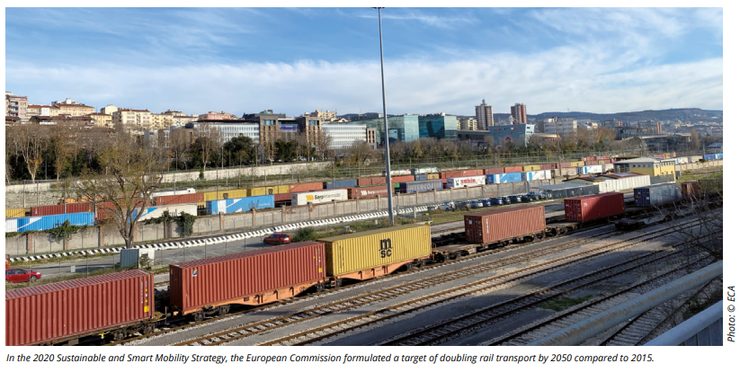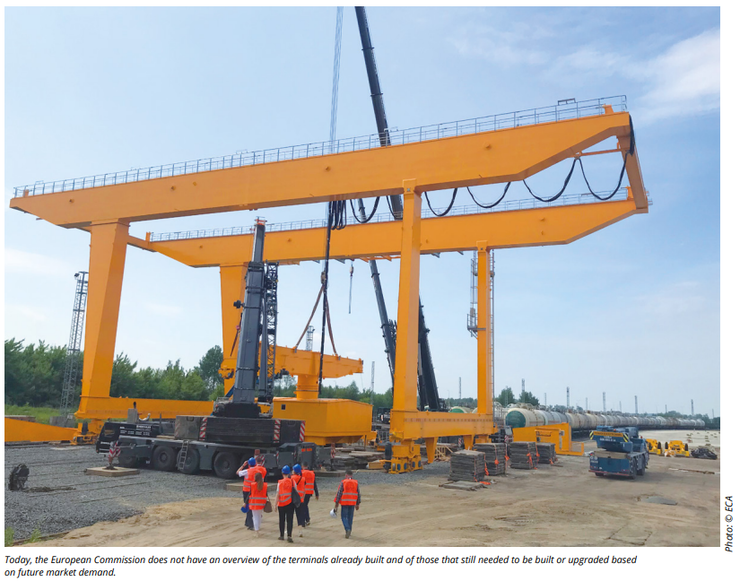Intermodal freight transport in the EU: there is still a long way to go
In order to promote the shift of freight transport away from the roads to alternative modes of transport such as rail, the EU provided more than 1.1 billion euros for intermodality projects between 2014 and 2020. However, as a special report by the European Court of Auditors published at the beginning of 2023 shows, the EU is still far from reaching its goal. This article presents the most important conclusions of the report with regard to infrastructure. In order to achieve the environmental goals, the EU is called upon to tackle these challenges.
Guido Fara, Auditor, European Court of Auditors

Since 2011, the European Commission has developed targets for reducing greenhouse gas emissions coming from the transport sector. One way for achieving such targets is a substantial modal shift from road transport to rail, inland waterways or short-sea shipping. Intermodal freight transport could be an asset in this effort, combining different transport modes to take advantage of their relative strengths.
The European Court of Auditors published earlier this year a special report assessing the effectiveness of the EU’s regulatory and financial support for intermodal freight transport since 2014. The auditors looked at several factors affecting the competitiveness of intermodality, namely the design and monitoring of the EU targets on intermodality, the support provided by the EU regulatory framework and the fitness of the EU infrastructure network for intermodality needs. This contribution presents the main conclusions as far as the infrastructure pillar of this audit was concerned.
Linear infrastructure and transhipment terminals are of central importance
To consistently opt for alternatives to road-only transport, economic operators need (a) linear infrastructure, such as railway tracks, meeting the necessary technical requirements, as well as (b) transhipment terminals to transfer freight from one transport mode to another.
While the EU is laying down requirements for its infrastructure network, the prioritisation of projects for implementation is the member states’ competence. Notwithstanding the progress achieved, interoperability issues and bottlenecks remain. Two technical parameters stood out for their relative low compliance across the trans-European transport network corridors (TEN-T corridors) forming the backbone of the EU transport network.
Train length and rail gauge: two parameters with low compliance rate
One of them is the train length, which is key in achieving economies of scale and improve the cost-effectiveness of intermodal transport. According to the European Commission, in 2019 only 53% of the TEN-T corridors allowed train operators to run 740-metre trains, which is the target length to be achieved by 2030.
The other parameter showing low compliance is the P400 rail gauge to accommodate large intermodal units. In this case, only 40% of the corridors allowed the operation of such trains, with strong variation across member states (in the case of Spain only 6% of the corridors were compliant).
Need for terminals: overview is lacking
When looking at transhipment terminals, the EU auditors found that information on existing intermodal ones was difficult-to-access, with long and costly procedures for logistics operators to retrieve information when designing new routes. Moreover, at the time of the audit, the European Commission was about to issue recommendations on the digitalisation of the logistics chain. In the meantime, however, EU countries had started to develop their own national solutions, with variations in the type of information collected.
The auditors also found that the European Commission did not have an overview of the terminals already built and of those that still needed to be built or upgraded based on future market demand. The 2021 Commission’s proposal to revise the TEN-T regulation (which is still going through the legislative process) and new conditions to obtain EU co-funding are however an opportunity to improve the situation, as member states will have to assess their needs for new terminals and share this information with the European Commission.
Delays in implementation and no monitoring of modal shift results
Finally, the auditors looked at a sample of EU funded infrastructure projects aimed at supporting intermodality. They found that their implementation often incurred delays, also due to an increased need of coordination among different entities. Moreover, the projects did not systematically estimate ex-ante or monitor ex-post their modal-shift results, hindering the possibility to identify good practices and common challenges when funding intermodal projects.
Conclusion: Progress in all areas urgently needed
All these aspects will need to be urgently addressed if intermodal freight transport is to increase its competitiveness against road-only transport and effectively contribute to the EU green transport objectives.



